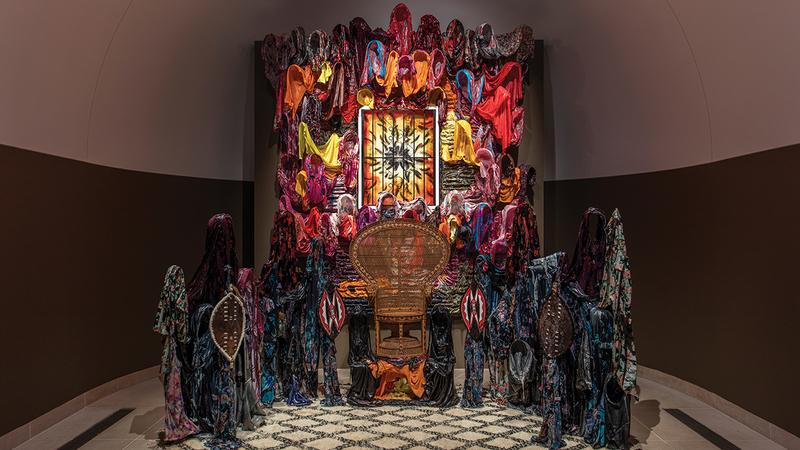While the 21st Century has ushered in an onslaught of changes in the way that we intake and utilize media, one thing that has not changed is the power of art as a cultural, political, and spiritual tool. The Catholic Reformation as a movement relied on artists like Gian Lorenzo Bernini to reshape and reinforce the teachings of the Church through artistic medium while similarly, the Black Panther movement used imagery and specifically photography to illustrate its identity and motivations. Alluding to both of these realities in his work Chair of the Ministers of Defense (2016), Kevin Beasley creates a conjunctive space for viewers that requires an acknowledgment of that which is present and that which is absent. In Chair of the Ministers of Defense, Kevin Beasley uses the colored window to invoke specific touchstones of Black life through color, artistic allusions, and symbols.
Throughout Chair of the Ministers of Defense, the distinct distribution of color used to portray light, hope, and presence concentrates in and around the window. While no glaringly bright colors are found in the foreground besides what is underneath the throne, all of the bright reds, yellows, and oranges are either located inside the window or surrounding it. As a result, a viewer’s eye is led directly to the window as a source of light in response to the dark, unforgiving nature of what is closest in proximity. The warm, bright colors held in the panes of the window provide the hope that the rest of its environment lacks. However, the window is barred, its promising light is inhibited by the constrictive conditions of a metal grate. Color has leaked onto the background, but it has not been able to spread completely. It points to an outward movement that while inevitable can still be contained. The same could be said for the Black community: a body of people that has long faced silencing but has never stopped fighting. This perseverance is not just seen in the colors Beasley uses but also in the spiritual references he brings into conversation with an African American reality.
By alluding to the Cathedra Petri (1666) altarpiece by Gian Lorenzo Bernini, Beasley forces the reader to draw out the relational similarities and differences between his artwork and Bernini’s and thus realize the implications of said comparative relationship. While the entirety of the Chair of the Ministers of Defense refers to Bernini’s Cathedra Petri, one of the most striking similarities are the windows–one containing a dove and the other containing a guinea fowl’s feathers. On one end this resemblance brings closer attention to the distinct surroundings of each window. The alabaster window in St. Peter’s contains a dove, a motif of the Holy Spirit, enclosed in an outpouring of golden cherubs and clouds. Meanwhile, the window in Chair of the Ministers of Defense holds the feathers of a guinea fowl, an emblem of protection, surrounded by resined fabric from the stores of Harlem. Through this detail, Beasley is not just addressing the economic inequality between the represented communities. Instead, he has his sights set on the issue of power and its portrayal. Beasley inspires in the viewer’s mind a well-established Christian symbol (the dove window) but then turns it on its head and obliterates the icon, leaving behind a mess of feathery debris. He destabilizes mainstream power and creates an internal conflict of where one turns when the ruling power is gone. Chair of the Ministers of Defense argues that perhaps there is something to be learned from Black communities who find power in solidarity despite lacking privileged societal power. That is not to say that Beasley undercuts or sugarcoats the harsh realities of systemic racism; that is to say, his artistic reference to Bernini only begins to unearth how symbolism can simultaneously uplift one group of people and depress another.
Through accessible and recognizable symbols within the window, Beasley creates a new frame of reference that shows how those same utilized objects are employed to oppress the Black community. One of the most glaring symbols revolving around the windows is the bars it flaunts. The metal bars imply that the window is not meant to be gazed out of but rather to separate, isolate, and segregate the viewer from what is held within. An observer conscious of this detail cannot deny its correlation to imprisonment and the larger issue of mass incarceration with its disproportionate effect on people of color. Even the decorative elements of the window’s frame further this reference. The two metal circles in the top and bottom levels of the grate bear a resemblance to heads peering through the bars with spiralized arms grasping onto the bars in hope of reaching through them. Meanwhile, the circularity of the design condemns all movement to an infinite loop where liberation is less than feasible. While the bars themselves leave room for escape, the bird feathers found inside the glass present a different narrative.
What once was a caged bird no longer dwells inside the cage; all that remains are fragments of his clipped wings: a signifier that the bird itself was never meant to be seen. But it is not a normal household bird confined to the cage, rather it is a wild guinea fowl, a symbol of protection in African tradition. What more can be said about imprisoning a symbol of security and confidence from the cultural roots of the systematically disadvantaged African American people? Why clip the wings of those who already could not fly? The only answer that reasonably comes to mind is to further ensure that resistance and freedom are not an option. Although a bird with clipped wings may have lost its ability to fly, its voice is not silenced. In her poem “Caged Bird,” Maya Angelou illustrates the plight of the imprisoned bird:
But a bird that stalks
down his narrow cage
can seldom see through
his bars of rage
his wings are clipped and
his feet are tied
so he opens his throat to sing.
The caged bird sings
with a fearful trill
of things unknown
but longed for still
and his tune is heard
on the distant hill
for the caged bird
sings of freedom.
Angelou conceptualizes an experience widely felt by the Black community in America: one where a voice is the only guarantee of personal power in a society where equality does not mean equity. As much as the caged bird can sing, it depends on a listener for its message to reach beyond the silence. Similarly, the window in Chair of the Ministers of Defense relies on an attentive viewer to draw out the symbolism and better understand the struggles of the minoritized community it represents.
Chair of the Ministers of Defense (2016) by Kevin Beasley seeks to portray that difficult process of meaning-making and odds-defying resistance in light of a racially oppressive society. Between allusions to the Cathedra Petri by Bernini and photographic monuments of the Black Panther movement, Beasley uses the window in his piece as an integrated invocation of Black life through color, artistic allusions, and symbols. In today’s world where systematic racism continues to rear its ugly head, Beasley’s work is an exemplary reminder to viewers that a reformed society begins with seeing the world around us through the lens of, in the words of Howard Thurman, “the man whose back is against the wall” (13) rather than the view of the one who put him there.

